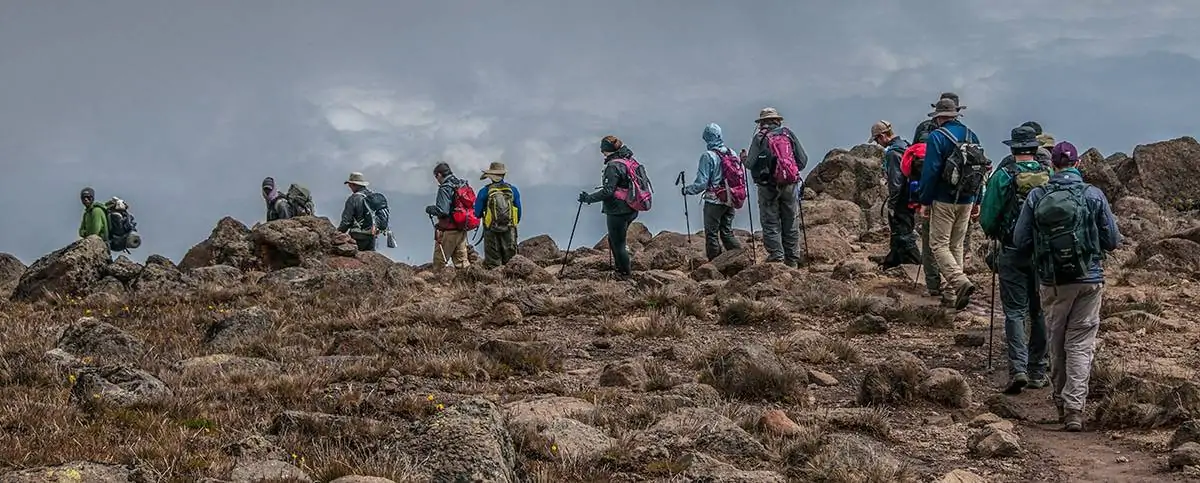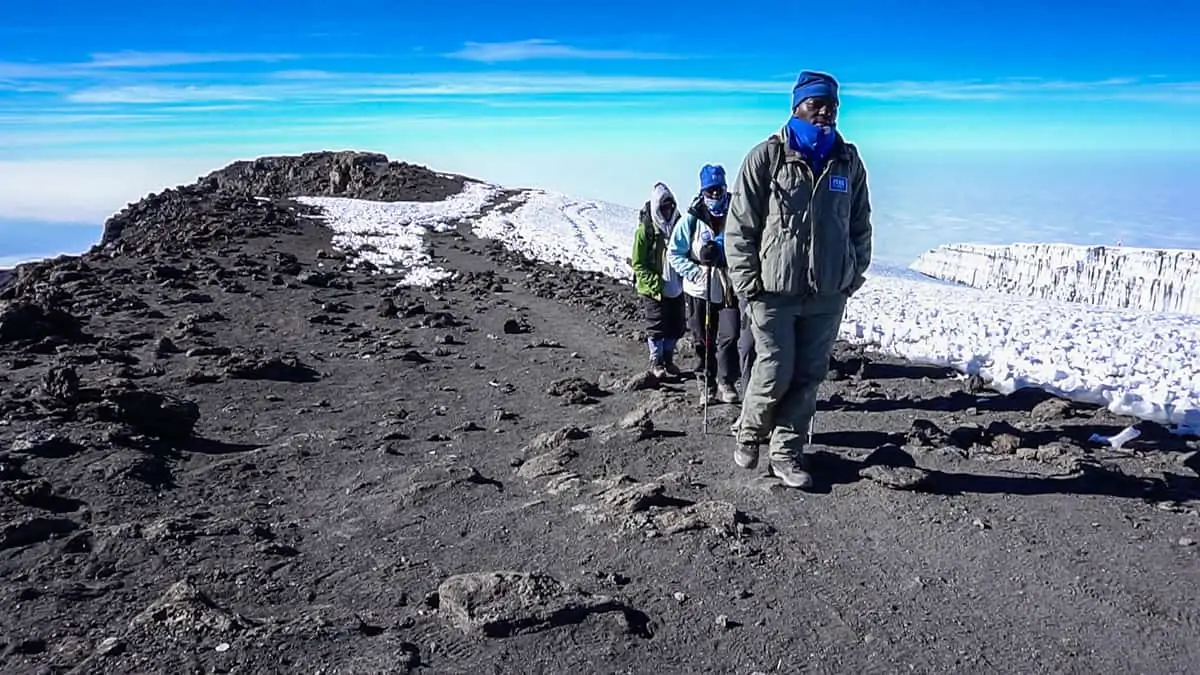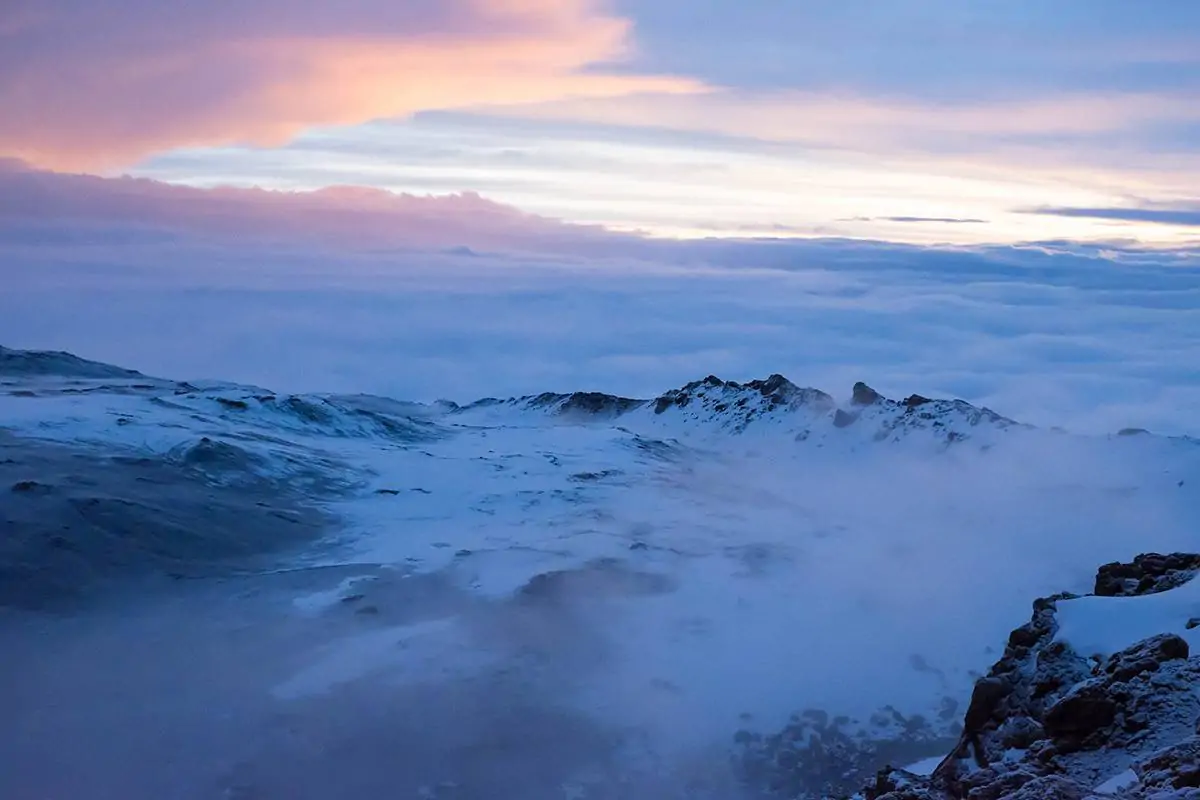Daily Schedule
What is the Typical Daily Hiking Schedule?
On a typical day on the mountain, your porter/waiter will wake you up around 6:30AM. He will bring you a warm pan of water to wash your face and hands. Breakfast will then be served. Meals are served in a mess tent – complete with chairs, tables, dinnerware and silverware. After you fill your water bladder and pack your daypack, you will begin walking around 8:00AM. The porters will stay behind and clean and pack up the campsite.
 The number of hours walking will vary from day to day. Your average walking time will be around four to six hours per day. During the walk, your guide will decide the pace and when to take breaks depending on his assessment of the party’s performance. The porters consistently move ahead of the group in order to prepare food, collect water, and set up tents so that everything is ready when the party arrives. A box lunch is provided to you at breakfast and you can eat part or all of it throughout the day.
The number of hours walking will vary from day to day. Your average walking time will be around four to six hours per day. During the walk, your guide will decide the pace and when to take breaks depending on his assessment of the party’s performance. The porters consistently move ahead of the group in order to prepare food, collect water, and set up tents so that everything is ready when the party arrives. A box lunch is provided to you at breakfast and you can eat part or all of it throughout the day.
Once you arrive at the campsite, snacks are served. Then, before dinner, a pan of water is again provided for clean up. Dinner is served around 6:00 PM. The guide will discuss the next day’s events with the group after dinner. There is plenty of downtime that can be spent chatting with your fellow climbers, staff and others sharing the campsite, reading, or otherwise relaxing.
Hiking Concerns
Clients commonly express concern that they will be “too slow” and lag behind the guide and the rest of their group. This concern is unwarranted. Being slow is fine, and in fact, required. The guides set a very slow hiking pace to give everyone the best chance to acclimatize to the increasing altitude. People who are turned back on the mountain typically do so because they have succumbed to altitude sickness, not because they were physically too tired to keep up or continue.
Summit Day
 The summit day climb starts the night before. After an early dinner and bedtime, the climbers are wake up around midnight. After a light snack, climbers begin their summit climb in darkness. It is cold and possibly windy. Summit day is a tough, 11 to 16 hour day. This monumental effort is what makes climbing Kilimanjaro an achievement. The guides try to time their trekking party to reach Stella Point at sunrise. It goes without saying that under these conditions, climbing is difficult, especially on loose rock and up a very steep trail. From Stella Point to the summit is an additional 40-60 minutes. You will pass by magnificent glaciers and stunning ice fields.
The summit day climb starts the night before. After an early dinner and bedtime, the climbers are wake up around midnight. After a light snack, climbers begin their summit climb in darkness. It is cold and possibly windy. Summit day is a tough, 11 to 16 hour day. This monumental effort is what makes climbing Kilimanjaro an achievement. The guides try to time their trekking party to reach Stella Point at sunrise. It goes without saying that under these conditions, climbing is difficult, especially on loose rock and up a very steep trail. From Stella Point to the summit is an additional 40-60 minutes. You will pass by magnificent glaciers and stunning ice fields.
Finally, once you reach the summit, a short time is spent celebrating and taking photos, before returning to high camp. At high camp you will be served lunch to regain your strength. After a brief time, you’ll descend to a much lower camp. The long descent immediately after summiting is where most people get tired. This is due to the partial night’s sleep, the expenditure of energy required to reach the top and the long, grueling distance covered that day. This fatigue is completely normal.
Altitude Acclimatization
In Addition, how one reacts to high altitude is uncertain. Everyone’s body is different. Some adjust well to the decreased oxygen levels; others do not. Being physically fit and in good health, although helpful, is no guarantee of your ability to acclimatize. Therefore the best advice we can give is to take 7 or more days on the mountain and to follow our acclimatization guidelines. You can also rent ALTOX or take Diamox to help with the accent
 There is a strong correlation between the amount of time spent on the mountain and the summit success rate. Because the human body adapts to high altitude slowly, the more time it has, the better the chances of acclimatization. A successful summit is usually a question of how well a climber can acclimatize to the high altitude, rather than the climber’s ability to ascend. By trekking standards, most of the day hikes on Kilimanjaro are not very strenuous. The big exception to this is the summit attempt, which requires a tremendous effort and is hard for nearly everyone. Climbers who acclimatize well to the altitude have a great chance of making it to the top. For every day less the success rate drops up to 20%. For example, the Lemosho 10-Day Route has an over 90% success rate.
There is a strong correlation between the amount of time spent on the mountain and the summit success rate. Because the human body adapts to high altitude slowly, the more time it has, the better the chances of acclimatization. A successful summit is usually a question of how well a climber can acclimatize to the high altitude, rather than the climber’s ability to ascend. By trekking standards, most of the day hikes on Kilimanjaro are not very strenuous. The big exception to this is the summit attempt, which requires a tremendous effort and is hard for nearly everyone. Climbers who acclimatize well to the altitude have a great chance of making it to the top. For every day less the success rate drops up to 20%. For example, the Lemosho 10-Day Route has an over 90% success rate.

